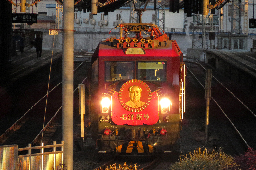Possibly thousands. This is south of Seattle. Because roads were given millions of dollars but railroads were given none and not nationalized, the railroad industry declined rapidly.
Wonderful how "western" countries "decided" to cripple themselves in such obvious way and ultimately fucking up the whole planet by doing so.
This is the perfect example of how a capitalist society will naturally become less and less efficient. There were (and are) two competing transportation systems, trains and cars. Or put another way, which can extrapolate to a million other examples, public versus private.
Imagine there are two regions far from each other, but under the same economic and political conditions. One has cars and very few trains, and the other has trains and very few cars. The one with trains, because its more efficient, will cost people less money, thereby supporting less profits for the capitalists. The industries that would benefit from switching to cars know they would make a lot of money, and would be willing to spend money up front, if they knew they could become the dominant system. Thats where the corruption comes in. And it works its way through media and government.
In the other region, where cars dominate, there isn't as much lost potential profit for the industries that support trains. So there aren't train advocates able to corrupt the system to switch away from cars.
So when its good for people, like good public transportation, there will be pressure to destabalize it. When its bad for people, like when everyone needs to own a car, buy gas, have insurance, pay parking tickets and speeding tickets, and mechanics bills, etc, the only pressure to destabalize it is organized demands from the masses. Like some sort of grassroots movement, which will never happen, because there are too many other more urgent issues, the changes needed are confusing, and we're not organized.
I mean we did nationalize the railroads, but in the shittiest possible way: we nationalized the passenger services that were losing money (and some freight in the northeast) but we didn't nationalize the fucking track! Nixon you dickhead.
But see owning the track, even though the government owned the fucking land in the first place would be communism or something
literally this morning i was staring agape at pictures of electrified railroads in the U.S. from the 70s. i had no fucking idea we had an electric route from D.C. to NYC. this was after playing some Workers & Resources and marveling at the electric railroad system you can build
it's pretty addictive but seems to be designed for people that love something in between a city/micronation sim, transport fever and a factorio type resource game. not so much a "beautiful aesthetic designed city" instead being more organic, do what works for the moment, fix later. you basically make your own goals but the mod selection is excellent. tons of community maps of bombed out, post WW2 socialist states for you to clean up, modernize and turn into industrial powers or even post-scarcity. it needs polish (like notification bubbles or something or a message system outside of just clicking on buildings), passage of time flexibility, and better building organization/info. you can play with auto build like cities or sim city (pay $ and resources) but the complexity really shines when you actually mobilize a full construction industry and watch your little mechanisms and trucks go to work but prepare to wait and plan your constructions. Sorry I could go on but i was also looking at it for months and i don't regret paying full price for it.
Ooh, sounds like a grand olde time. Will buy it if I ever get money again
If you grew up in a town of 20k to 200kish that was around pre-WW2 and really want to make your blood boil, do some digging on what kind of streetcar system your hometown used to have. We all pretty much had Germany-level systems, even random shithole backwaters.
Fucking LA out of all places had the Red Car network which today would be a complete streetcar system/interurban for the entire region. One they are trying to recreate only a fraction of with massive costs.
Or checkout the interurbans that ran in the Chicago area. Being a large city Chicago of course has an extensive streetcar network (that they replaced with shitty buses) but it also had an equally extensive interurban network. So you could go from streetcar to interurban to get to the ring cities like Elgin, Aurora, Joliet, etc. You could also go BETWEEN those cities. Hell you could take it all the way to Milwaukee. All electric, all light rail. The only remaining parts of this I think are the South Shore Line and the CTA Skokie Swift which uses part of the extensive North Shore Line.
http://www.encyclopedia.chicagohistory.org/pages/648.html
I could talk about this for hours. When I was younger, I got very curious about trains and the old rail stations that used to exist before all the big highways. Living in the rural south, I had discovered this from researching history and I used to wonder to myself as a kid; how come no one has created some kind of transportation system that would take us from our rural small towns and into the big cities?
Well, come to find out, Alabama once had rail stations and plans to build rail cars that would've connected all of the big cities across the state and with stops in the rural areas making it easier to navigate the state. All of this was gutted after the auto industry boomed and they installed giant highways and interstates instead.
New Orleans also had rail cars (still do but to a very lesser extent) and plans to build a complete transportation system around the city and state of Louisiana. That too was gutted in favor of the car.
Robert Caro's book 'The Power Broker' is a great run down on Robert Moses and how he constructed the road system of New York City to be based entirely around cars. There is one chapter entirely dedicated to being stuck sitting in traffic for hours. The entire US highway system of interstates and giant roads was done to force the car as the one vehicle everyone has to own and be stuck with.
As late as the 1940s, you could take a train from small Midwest towns pretty much anywhere you wanted to go. My grandparents grew up in small towns/on farms and never had a car as kids. Some of that was the economic, of course, but "lack of being able to get places" was never really something that anybody considered a struggle, because it wasn't! The Iron Horse had you covered, and towns were built so that you could walk, or take the streetcar once they got "big" (as in about 20,000 people)
There is now zero regular passenger train service unless you're within ~70 miles of Chicago (the "Amtrak" routes almost always get bus substitutes)
Consider, for example, the Burlington Zephyr, described by the Saturday Evening Post as “a prodigious, silvery, three-jointed worm, with one stalk eye, a hoofish nose, no visible means of locomotion, seeming either to be speeding on its belly or to be propelled by its own roar,” which barreled from Chicago to Denver in 1934 in a little more than 13 hours. (It would take more than 18 today.) An article later that year, by which time the Zephyr had put on the “harness of a regular railroad schedule,” quoted a conductor complaining the train was “loafing” along at only 85 mph. But it was not uncommon for the Zephyr or other trains to hit speeds of more than 100 mph in the 1930s. Today’s “high-speed” Acela service on Amtrak has an average speed of 87 mph and a rarely hit peak speed of 150 mph. (The engine itself could top 200 mph.)
When I was a kid we would go to a train museum and they had a Zephyr there. They also had about 10 miles or so of track to run trains on and one weekend a year they would run the Zephyr on it with passengers. So one year we were lucky enough to get tickets in time. Holy shit that was the most beautiful train I’ve ever been on. From the dinning area to the coach and sleeper cars everything was top 1930s amenities. Damn thing even had A/C. And FAST. Think it got up to around 90 and it was as smooth of a ride as trains I’ve been on in the EU. But only America would throw away something like that to make even more money off of the automobile.
Keep in mind that I am only referring to mainline rail here. Including interurban lines and streetcar lines would push the number way, way up.
Thank you Chapo poster for giving me insight into a new type of depression: seeing a diesel locomotive running on an electrified track depressed.
The visceral hot shit mess that is north American rail is violence against logic
I've literally never been on a train in my life. We have a ton of rail, but it's for supplying coal to the power plant by the highschool and that just switched to LNG so they're just ripping up the tracks to make way for luxury condos. We used to have a street car system in the 20s, but they tore it all up and took the remaining streetcars and put diesel engines and tires on them so they're just shitty buses. Then they sold them to a local brewery to ferry drunk patrons to their cars at a parking lot across town.
Fuck America.
I hate diesel trains all my homies hate diesel trains
Just why? Electric trains are more powerful than diesels and they don't need oil to run, which even if you don't give a shit about the environment, is better for energy security because you don't need to import oil to make them work.
Bring back the GG1
Etalin is an ecofascist who wants to ban all vehicles, especially the sexy ones.
The weirdest part is that official end of Milwaukee road electrification came in 1974 after the oil crisis of 1973, which was followed by another oil crisis six years later! Man, we fucked up by letting that get away.
South shore line is even electrified for passenger service and runs their freight with diesels.
Iowa traction is a fun little oddity.
Black Mesa and Lake Powell was pretty interesting, but it shut down last year.
Railroads were somewhat nationalized at various points, look at conrail, although they were mostly east of Chicago.









